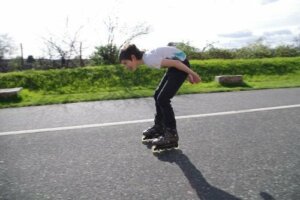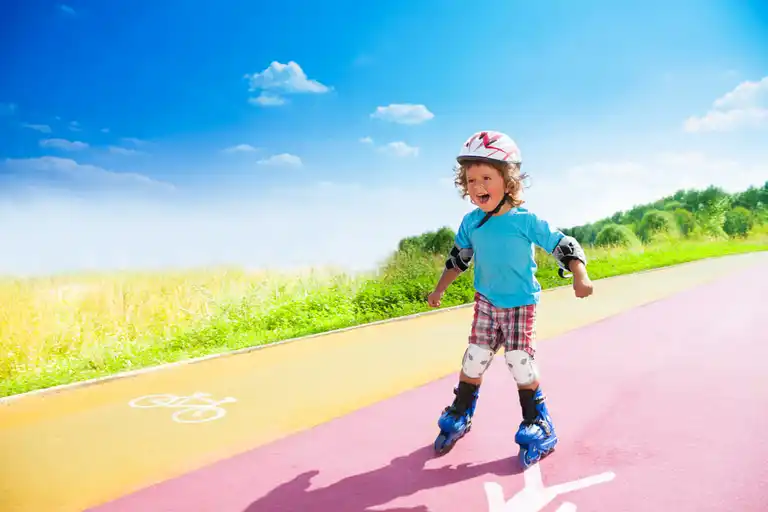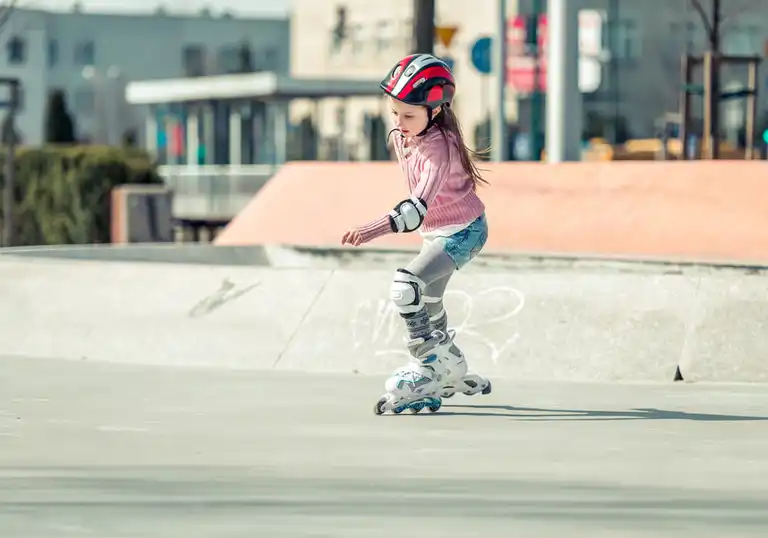Tips for Children to Learn to Skate

Are your children interested in skating? Don’t hesitate and help them to learn to skate as soon as possible. Skating is fun but it’s also a useful sport to develop balance in children.
In addition, what’s more, it’s a popular activity these days. Many children want to learn to skate, which is a fun and very healthy activity. But sometimes it isn’t easy during the first attempts.
The first thing that children have to do is choose what type of skates they want to use: The traditional type–with two wheels in the front and two in the back–or in-line skates, also known as rollers. The latter are made up of four rubber wheels in a straight line on the same axis. They can also learn to ice skate if they wish.
It’s best for children to wait to learn to skate until they’re at least 4 years old and that they do so with very simple exercises. From the age of 7, if they’ve already learned the basics and have some skill, they can learn more complicated and complex exercises.

The benefits of skating
Skating is fun, but it’s also a healthy exercise for children. If they want to learn, try to help and encourage them. It’s a physical activity that strengthens the leg muscles and improves your physical endurance. What’s more, it also helps them improve their balance and concentration.
Children must always use a special, approved, and well-fitting helmet. Don’t forget it because it will protect them in the event of blows to the head. They must also use knee pads and elbow pads to protect joints. Furthermore, they also have to wear wristbands and protection on the palms of the hands to prevent damage to the wrists.
They should also wear comfortable and resistant clothing. It’s very important that the skates are well adjusted. Check that they don’t move to the sides or that they’re not loose. It’s important that you buy the right size skates or that they’re adjustable.
The first steps to learn to skate
The best thing is to sign your little ones up for skating lessons so they can learn to get on the skates and start gliding. The instructors usually have a lot of experience and know how to help kids improve their balance. They usually do exercises and practical games so that they learn to skate.
If this isn’t possible, parents will have to patiently help them learn to skate with simple exercises. The most important thing is that they learn to get on the skates and acquire balance, as well as fundamental skills like learning to stop, change directions, and skate with obstacles.
A good idea is to start by practicing on a carpet or grass. You can set out a chair for them to lean on and gain balance. Skates will not roll as easily on these surfaces and this will allow your children to gradually improve their skills in a safe way. Try to get your children to stabilize their bodies using their arms. First, let them hold on to you until they gain confidence if they’re afraid of falling. Then you’ll have to go little by little until they can balance and let go.
Try not to get overwhelmed if they don’t go as fast as you think they should. It’s important that they gain confidence and not worry if they fall again and again. Skating may not be easy at first for children. Try to motivate them at all times. Be very patient when they’re practicing and you’ll see how in a short time, your children will have learned. Once they acquire the basic knowledge, they’ll be able to skate safely and even participate in races with friends or in competitions.

Practical tips
It’s always a good idea to visit the area where our children are going to skate in advance to see if there’s any danger. Don’t skate on uneven surfaces or surfaces that aren’t flat. Look for places that don’t have any obstacles with sand, water, stones, or holes. Children shouldn’t skate on streets or roads where any vehicles may travel, and they should never be attached to cars, motorcycles, or bicycles in order to move forward.
It’s important that they learn the technique well from the beginning in order to avoid falls and injuries. Be very patient so that they gain confidence and learn the basic movements quickly.
Try to get them to practice almost every day so they can skate better and better. With just half an hour, they’ll remember what they learned. The keys are that they gain confidence, practice a lot, and that they enjoy skating whenever they want and feel like it. Skating is an exercise that will keep them active and healthy.
Are your children interested in skating? Don’t hesitate and help them to learn to skate as soon as possible. Skating is fun but it’s also a useful sport to develop balance in children.
In addition, what’s more, it’s a popular activity these days. Many children want to learn to skate, which is a fun and very healthy activity. But sometimes it isn’t easy during the first attempts.
The first thing that children have to do is choose what type of skates they want to use: The traditional type–with two wheels in the front and two in the back–or in-line skates, also known as rollers. The latter are made up of four rubber wheels in a straight line on the same axis. They can also learn to ice skate if they wish.
It’s best for children to wait to learn to skate until they’re at least 4 years old and that they do so with very simple exercises. From the age of 7, if they’ve already learned the basics and have some skill, they can learn more complicated and complex exercises.

The benefits of skating
Skating is fun, but it’s also a healthy exercise for children. If they want to learn, try to help and encourage them. It’s a physical activity that strengthens the leg muscles and improves your physical endurance. What’s more, it also helps them improve their balance and concentration.
Children must always use a special, approved, and well-fitting helmet. Don’t forget it because it will protect them in the event of blows to the head. They must also use knee pads and elbow pads to protect joints. Furthermore, they also have to wear wristbands and protection on the palms of the hands to prevent damage to the wrists.
They should also wear comfortable and resistant clothing. It’s very important that the skates are well adjusted. Check that they don’t move to the sides or that they’re not loose. It’s important that you buy the right size skates or that they’re adjustable.
The first steps to learn to skate
The best thing is to sign your little ones up for skating lessons so they can learn to get on the skates and start gliding. The instructors usually have a lot of experience and know how to help kids improve their balance. They usually do exercises and practical games so that they learn to skate.
If this isn’t possible, parents will have to patiently help them learn to skate with simple exercises. The most important thing is that they learn to get on the skates and acquire balance, as well as fundamental skills like learning to stop, change directions, and skate with obstacles.
A good idea is to start by practicing on a carpet or grass. You can set out a chair for them to lean on and gain balance. Skates will not roll as easily on these surfaces and this will allow your children to gradually improve their skills in a safe way. Try to get your children to stabilize their bodies using their arms. First, let them hold on to you until they gain confidence if they’re afraid of falling. Then you’ll have to go little by little until they can balance and let go.
Try not to get overwhelmed if they don’t go as fast as you think they should. It’s important that they gain confidence and not worry if they fall again and again. Skating may not be easy at first for children. Try to motivate them at all times. Be very patient when they’re practicing and you’ll see how in a short time, your children will have learned. Once they acquire the basic knowledge, they’ll be able to skate safely and even participate in races with friends or in competitions.

Practical tips
It’s always a good idea to visit the area where our children are going to skate in advance to see if there’s any danger. Don’t skate on uneven surfaces or surfaces that aren’t flat. Look for places that don’t have any obstacles with sand, water, stones, or holes. Children shouldn’t skate on streets or roads where any vehicles may travel, and they should never be attached to cars, motorcycles, or bicycles in order to move forward.
It’s important that they learn the technique well from the beginning in order to avoid falls and injuries. Be very patient so that they gain confidence and learn the basic movements quickly.
Try to get them to practice almost every day so they can skate better and better. With just half an hour, they’ll remember what they learned. The keys are that they gain confidence, practice a lot, and that they enjoy skating whenever they want and feel like it. Skating is an exercise that will keep them active and healthy.
All cited sources were thoroughly reviewed by our team to ensure their quality, reliability, currency, and validity. The bibliography of this article was considered reliable and of academic or scientific accuracy.
- Cámara, J. M., & Campazas, H. R. (2011). Propuesta para abordar el qué y cómo enseñar las habilidades motrices en secundaria: un ejemplo a través del patinaje. Ágora para la educación física y el deporte, 13(2), 197-228. https://dialnet.unirioja.es/servlet/articulo?codigo=3696636
- Vila, R., Guitart, N., Riera, J., & Díaz, J. (2007). Aprendizaje y enseñanza de las habilidades con patines. Apunts Educación Física y deportes, (90), 27-32. https://www.redalyc.org/pdf/5516/551656950004.pdf
- Mayorga Marín, J. Y., & Mejía Lugo, Z. (2013). Propuesta pedagógica como medio para fortalecer la coordinación dinámica general a partir de la práctica del patinaje en los niños y niñas del grado transición del Jardín Infantil Andy Panda(Bachelor’s thesis, Universidad Libre). https://repository.unilibre.edu.co/handle/10901/7653
This text is provided for informational purposes only and does not replace consultation with a professional. If in doubt, consult your specialist.








